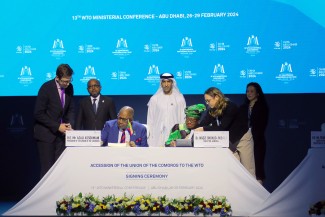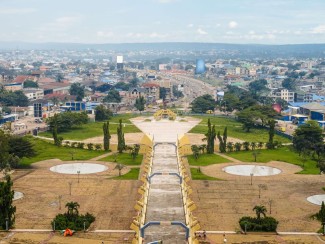|
|
|
The African Continental Free Trade Area (AfCFTA) is designed to create an integrated continental market for goods and services and to support the movement of capital and natural persons. It is expected to enhance competitiveness, promote industrial development through diversification and regional value chain development and to promote sustainable socio-economic development and structural transformation.
These broad development objectives are particularly important to the 32 least developed countries (LDCs) that are among the 55 member states of the African Union (AU) engaged in this initiative.
The AfCFTA is being negotiated in two phases. Trade in goods and services and dispute settlement are negotiated in phase 1. Phase 2 negotiations will focus on investment, competition policy and intellectual property rights. The Agreement entered into force on 30 May 2019, when 22 member states had deposited their instruments of ratification.
Outstanding negotiations are critical to LDCs
Despite impressive progress in the negotiations, it is still not possible to trade under the AfCFTA. The reason is that negotiations of preferential tariff concessions and rules of origin have not been completed. These are the minimum requirements for a free trade area.
For LDCs these outstanding negotiations are critical. The potential loss of tariff revenue from liberalisation, despite the low levels of intra-Africa trade, is a matter of concern for some. And the import tariff is also a very effective measure to protect domestic industry from import competition.
Both variable geometry and special and differential treatment are negotiating principles for the AfCFTA. Member states have agreed to liberalise 90% of tariff lines. The agreed timeframe for achieving this level of ambition is 10 years for LDCs and 5 years for non-LDCs.
Of the remaining 10% of tariff lines, 7% can be designated sensitive and 3% of tariff lines can be excluded from liberalisation. LDCs will eliminate tariffs on sensitive products over 13 years. They can backload reduction of these tariffs – effectively maintaining their current tariffs for the first five years. Non-LDCs have 10 years to eliminate tariffs on sensitive products; they may also backload liberalisation by only starting tariff reductions in year 6. Both LDCs and non-LDCs may exclude 3% of tariff lines, but the excluded products may not account for more than 10% of their total trade.
A group of 6 member states (the so-called G6), consisting of five LDCs (Ethiopia, Madagascar, Malawi, Sudan, Zambia) and Zimbabwe have drawn on the special and differential treatment principle. They have argued that they face specific development challenges and have managed to secure a 15-year phase-down period. The division of the remaining 10% of tariff lines between sensitive and excluded products, is still to be agreed.
This list clearly does not include all LDCs in the AfCFTA and specifically does not include Angola and Sao Tome and Principe, which are due to graduate from their LDC status in 2021 and 2024 respectively.
Member states have agreed to liberalise 90% of tariff lines. The agreed timeframe for achieving this level of ambition is 10 years for LDCs and 5 years for non-LDCs.
Member states have identified 5 priority services sectors – financial, communication, transport and business services, and tourism. Specific commitments for these sectors are still to be negotiated, and a framework for regulatory cooperation is to be agreed.
Services are increasingly important, also for LDCs, in terms of the contribution to economic activity, employment and trade. Financial, communication and transport services are inputs into all economic activity, and can contribute to enhancing economy-wide competitiveness.
Very importantly, services are also important for trade facilitation. For example, harmonisation of transport regulations such as axle load limits, could reduce transport-related costs of intra-Africa trade and trade with global partners.
To assist LDCs to develop domestic regulatory and institutional capacity for their services sectors, the AfCFTA should include support commitments.
AfCFTA is a flagship project of the African Union
The AfCFTA is not only a free trade area. It is also a flagship project of the AU.
The suite of AU flagship projects of Agenda 2063 includes PIDA (Programme for Infrastructure Development in Africa), AIDA (Accelerated Industrial Development for Africa) and BIAT (Boosting Intra-Africa Trade). They can play an important role in the development and diversification of African economies, attracting foreign direct investment and reducing trade costs among African countries. These, together with the AfCFTA, are complementary initiatives supporting Africa’s transformation and development agenda.
Several additional initiatives have been launched to support the AfCFTA. Afreximbank – Africa’s largest trade bank – has established a US$1 billion financing facility to support adjustment associated with trade liberalisation and loss of tariff revenue resulting from implementation of the AfCFTA.
In some regional economic communities, it is not uncommon for some member states to reintroduce tariffs that have been liberalised, when domestic businesses experience challenges. This undermines rules-based trade governance, and can be avoided by access to an adjustment facility or access to trade remedies and safeguards that are provided for in the AfCFTA.
A Pan-African Payment and Settlement System (PAPSS) – a continent-wide system developed by Afreximbank in collaboration with the AU – has also been launched. This platform aims to domesticate intra-regional payments. It could save the continent more than US$5 billion in payment transaction costs per annum.
Afreximbank – Africa’s largest trade bank – has established a US billion financing facility to support adjustment associated with trade liberalisation and loss of tariff revenue resulting from implementation of the AfCFTA.
The bank has also undertaken, in collaboration with international donors, to support Quality Assurance Centres to assist member states to comply with international standards and technical regulations. This is a very important contribution to support the development of productive capacity and ensure that products meet the standards that are essential for access to export markets.
A simplified trade regime for the AfCFTA is also to be developed. This is a very important facility, particularly in view of the very substantial communities of informal traders, many of whom are women.
Integration will remain a complex process
The AfCFTA is drawing significant interest on the continent and globally. Integration makes sense for Africa, and the AfCFTA is an important step towards this objective. But integrating unequal partners is a complex and difficult process, as is evident from the integration experience of African’s regional economic communities.
-------
Trudi Hartzenberg is Executive Director of the Trade Law Centre (tralac).
If you would like to reuse any material published here, please let us know by sending an email to EIF Communications: eifcommunications@wto.org.



